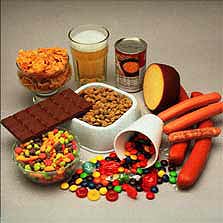Food Additive
Food additives are substances added to food to preserve flavor or enhance its taste and appearance. Some additives have been used for centuries; for example, preserving food by pickling (with vinegar), salting, as with bacon, preserving sweets or using sulfur dioxide as in some wines. With the advent of processed foods in the second half of the 20th century, many more additives have been introduced, of both natural and artificial origin.
List of food additive types

Food additives can be divided into several groups, although there is some overlap between them.
Acids
Food acids are added to make flavors "sharper", and also act as preservatives and antioxidants. Common food acids include vinegar, citric acid, tartaric acid, malic acid, fumaric acid, and lactic acid.
Acidity regulators
Acidity regulators are used to change or otherwise control the acidity and alkalinity of foods.
Anticaking agents
Anticaking agents keep powders such as milk powder from caking or sticking.
Antifoaming agents
Antifoaming agents reduce or prevent foaming in foods.
Antioxidants
Antioxidants such as vitamin C act as preservatives by inhibiting the effects of oxygen on food, and can be beneficial to health.
Bulking agents
Bulking agents such as starch are additives that increase the bulk of a food without affecting its nutritional value.
Food coloring
Colorings are added to food to replace colors lost during preparation, or to make food look more attractive.
Color retention agents
In contrast to colorings, color retention agents are used to preserve a food's existing color.
Emulsifiers
Emulsifiers allow water and oils to remain mixed together in an emulsion, as in mayonnaise, ice cream, and homogenized milk.
Flavors
Flavors are additives that give food a particular taste or smell, and may be derived from natural ingredients or created artificially.
Flavor enhancers
Flavor enhancers enhance a food's existing flavors. They may be extracted from natural sources (through distillation, solvent extraction, maceration, among other methods) or created artificially.
Flour treatment agents
Flour treatment agents are added to flour to improve its color or its use in baking.
Glazing agents
Glazing agents provide a shiny appearance or protective coating to foods.
Humectants
Humectants prevent foods from drying out.
Tracer gas
Tracer gas allow for package integrity testing to prevent foods from being exposed to atmosphere, thus guaranteeing shelf life.
Preservatives
Preservatives prevent or inhibit spoilage of food due to fungi, bacteria and other microorganisms.
Stabilizers
Stabilizers, thickeners and gelling agents, like agar or pectin (used in jam for example) give foods a firmer texture. While they are not true emulsifiers, they help to stabilize emulsions.
Sweeteners
Sweeteners are added to foods for flavoring. Sweeteners other than sugar are added to keep the food energy (calories) low, or because they have beneficial effects for diabetes mellitus and tooth decay and diarrhea.
